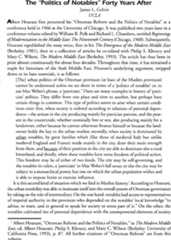- English
- Français
Article contents
The “Politics of Notables” Forty Years After
Published online by Cambridge University Press: 09 March 2016
- James L. Gelvin*
- Affiliation:UCLA
Abstract

Information
- Type
- Forty Years of MESA
- Information
- Copyright
- Copyright © Middle East Studies Association of North America 2006
Access options
Get access to the full version of this content by using one of the access options below. (Log in options will check for institutional or personal access. Content may require purchase if you do not have access.)Article purchase
Temporarily unavailable
References
1Hourani,Albert, “Ottoman Reform and the Politics of Notables,” inThe Modern Middle East, ed.Hourani,Albert,Khoury,Philip S., andWilson,Mary C. (Berkeley:University of California Press,1993), p.87.Google Scholar All further citations of “Ottoman Reform” are from this volume.
2Roniger,Luis, “Clientalism and Patron-Client Relations: A Bibliography,” inPolitical Clientalism, Patronage and Development, ed.Eisenstadt,S.N. andLemarchand,René (Beverly Hills:Sage,1981), pp.297–330.Google Scholar
3Khoury,Philip S., “The Urban Notables Paradigm Revisited,”Revue du Monde Musulman et de la Méditerranée 55–56 (1990):215–32.CrossRefGoogle Scholar
4Hourani,Albert, “The Present State of Islamic and Middle Eastern Historiography,” inEurope and the Middle East (Berkeley:University of California Press,1980), p.191.CrossRefGoogle Scholar
5Hourani,, “Ottoman Reform,” p.87.Google Scholar
6 Until recently, a correspondent affliction affected Ottoman imperial historians as well. SeeFaroqhi,Suraiya, “Coping with the Central State, Coping with Local Power: Ottoman Regions and Notables from the Sixteenth to the Early Nineteenth Century,” inThe Ottomans and the Balkans: A Discussion of Historiography, ed.Adanir,Fikret andFaroqhi,Suraiya (Leiden:Brill,2002), pp.351–81.Google Scholar
7 See,inter alia,Khoury,Philip S., “Continuity and Change in Syrian Political Life: The Nineteenth and Twentieth Centuries,”American Historical Review96:5 (December1991):1374–95CrossRefGoogle Scholar;Muslih,Muhamma,The Origins of Palestinian Nationalism (New York:Columbia University Press,1989)Google Scholar;Khalaf,Samir, “Changing Forms of Political Patronage,” inLebanon’s Predicament (New York:Columbia University Press,1987), pp.73–101.Google Scholar
8 SeeNaff,Thomas,Paths to the Middle East: Ten Scholars Look Back (Albany:SUNY Press,1993), p.48.Google Scholar The categories “foreigners,” “notables,” and “common people” are Lapidus’s. SeeLapidus,Ira, “Muslim Urban Society in Mamluk Syria,” inThe Islamic City: A Colloquium, ed.Hourani,A.H. andStern,S.M. (Oxford:Bruno Cassirer,1970), pp.195–205.Google Scholar
9Shils,Edward,Center and Periphery: Essays in Macrosociology (Chicago:University of Chicago Press,1975), pp. xl–xli.Google Scholar
10Naff,,Paths, pp.28,45.Google Scholar See alsoOwen,Roger, “Albert Hourani the Historian,” inMiddle Eastern Politics and Ideas: A History from Within, ed.Pappé,Ilan andMa’oz,Moshe (London:Tauris,1997), p.9Google Scholar;Gallagher,Nancy,Approaches to the History of the Middle East: Interviews with Leading Middle East Historians, (Ithaca Press,1994), p.36.Google Scholar
11 For the debt modernization theory owed to struc-func, see, for example,Latham,Michael E.,Modernization as Ideology: American Social Science and “Nation Building in the Kennedy Era (Chapel Hill:University of North Carolina Press,2000), pp.39–40.Google Scholar
12 SeeShils,,Center and Periphery, pp. xii,3–13Google Scholar;Eisenstadt,S.N. andCurelaru,M.The Form of Sociology: Paradigms and Crises (New York:John Wiley and Sons,1976), pp.179–82.Google Scholar
13Owen,, “Albert Hourani,” p.14.Google Scholar
14Hourani,, “The Present State,” p.187–88.Google Scholar
15Naff,,Paths, p.48.Google Scholar
16Eisenstadt,S.N. andRoniger,Luis, “The Study of Patron-Client Relations and Recent Developments in Sociological Theory,” inPolitical Clientalism,275Google Scholar;Eisenstadt, andCurelaru,,The Form of Sociology, pp.194–98.Google Scholar
17Lemarchand,René, “Comparative Political Clientalism: Structure, Process and Optic,” inPolitical Clientalism, Patronage and Development, ed.Eisenstadt,S.N. andLemarchand,René (Beverly Hills:Sage,1981), p.9.Google Scholar
18 According to E.P. Thompson, for example, “No thoughtful historian should characterize a whole society as paternalist or patriarchal. But paternalism can, as in Tsarist Russia, Meiji Japan, or in certain slave-holding societies, be a profoundly important component not only of ideology but of the actual institutional mediation of social relations.”Thompson,E.P., “Eighteenth-Century English Society: Class Struggle Without Class?,”Social History3:2 (May1978):137.CrossRefGoogle Scholar
19 Ibid., p. 135.
20 Ibid., p. 145;Gilsenan,Michael, “Against Patron-Client Relations,” inPatrons and Clients in Mediterranean Societies, ed.Gellner,Ernest andWaterbury,John (London:Duckworth,1977), pp.167–68, 179–80Google Scholar;Waterbury,John, “An Attempt to Put Patrons and Clients in their Place,” inPatrons and Clients in Mediterranean Societies, pp.329, 332–33.Google Scholar
21Thompson,, “Eighteenth-Century English Society,” p.136.Google Scholar
22Gilsenan,, “Against Patron-Client Relations,” p.181.Google Scholar
23Toledano,Ehud, “The Emergence of Ottoman-Local Elites (1700–1900): A Framework for Research,” inMiddle Eastern Politics and Ideas, p.146.Google Scholar
24Hourani,Albert, “The Ottoman Background of the Modern Middle East,” inThe Emergence of the Modern Middle East (Berkeley:University of California Press,1981), pp.2–3.CrossRefGoogle Scholar
25 See, for example,Hathaway,Jane, “The Military Household in Modern Egypt,”International Journal of Middle East Studies27 (February1995):39–52CrossRefGoogle Scholar;Toledano,, “The Emergence of Ottoman-Local Elites,” pp.145–62Google Scholar;Khoury,Dina Rizk,State and Provincial Society in the Ottoman Empire: Mosul 1540–1834 (Cambridge:Cambridge University Press,2002).Google Scholar
26Toledano,, “The Emergence of Ottoman-Local Elites,” p.155.Google Scholar
27 See,inter alia,Dawn,C. Ernest,From Ottomanism to Arabismi Essays on the Origins of Arab Nationalism (Urban:University of Illinois Press,1973)Google Scholar;Khoury,Philip S.,Urban Notables and Arab Nationalism: The Politics of Damascus 1860–1920 (Cambridge:Cambridge University Press,1983).CrossRefGoogle Scholar
28Hourani,Albert, “The Arab Awakening Forty Years After,” inHourani, (ed.),The Emergence of the Modern Middle East (Berkeley:University of California Press,1981), pp.201–2.CrossRefGoogle Scholar
29Hourani,, “Ottoman Reform,” p.100Google Scholar;Kedourie,Elie, “Pan-Arabism and British Policy,” inThe Chatham House Version and Other Middle-Eastern Studies (Chicago:Ivan R. Dee,2004), p.213.Google Scholar
30Hourani,, “The Arab Awakening,” p.202.Google Scholar
31 SeeKhoury,, “The Urban Notables Paradigm,” p.224.Google Scholar
32 For a more detailed discussion of these issues, see my “Post Hoc Ergo Propter Hoc?: Reassessing the Lineages of Nationalism in Bilad al-Sham,” inPhilipp,Thomas andSchumann,Christoph (eds.),From the Syrian Land to the State of Syria (Würtzburg:ERGON Verlag,2004), pp.127–44Google Scholar; “Modernityand Its Discontents: On the Durability of Nationalism in the Arab Middle East,”Nations and Nationalism 5:1 (January 1999): 71–89;Divided Loyalties: Nationalism and Mass Politics in Syria at the Close of Empire (Berkeley: University of California Press, 1998).
33Dawn,, “From Ottomanism to Arabism,” p.377.Google Scholar
34 A more thorough discussion of this phenomenon can be found inGelvin,, “Post Hoc Ergo Propter Hoc?” andGelvin,,The Modern Middle East: A History (New York:Oxford University Press,2004), pp.197–201.Google Scholar
35Hourani,, “The Arab Awakening” p.199.Google Scholar
- 15
- Cited by

